Intro
The Hundred Years War is one of the most famous conflicts of the Middle Ages. It opposes the kings of France of the Valois dynasty to the kings of England for the possession of the kingdom of France. The conflict can be divided into two periods during which the throne of France is about to fall under English tutelage, before observing an almost total reconquest. In each of these periods, an emblematic figure, a hero, embodies the French upsurge:
- The first period of the conflict saw England victorious at Crécy and Poitiers where the King of France was captured. The French surge is made thanks to the constable Bertrand du Guesclin and his king Charles V.
- The second period of the conflict saw the birth of a civil war:the Armagnacs against the Burgundians. This fight favors England, victorious at Agincourt. The throne is then promised to the King of England. It is Joan of Arc who will trigger the awakening of the French forces and their race towards victory.
The Origin of War
A century of struggle between French and English
The long period of struggle between France and England, which is known as the Hundred Years' War, was not exactly a war, and lasted well over a hundred years (116 years:from 1337 to 1453). Five kings of France and as many English sovereigns found themselves successively engaged in this duel. Three whole generations lived in a perpetual climate of troubles and fights. The Hundred Years War is broken down into a series of battles, separated by periods of relative peace, or truces. And when the fighting ceased, looting, famine or the plague finished ruining cities and countryside. If England was not spared by this war, France, on whose soil the battles took place, was more affected than its rival. However, she ends up having the upper hand. But the two belligerents emerged deeply changed from this age-old conflict.
The sovereign protagonists
| France | England |
|---|---|
|
|
The three suitors
On the death of Charles IV le Bel, the last of the direct Capetians, three claimants had equivalent rights to the crown:
- Philip, Count of Valois :Son of Charles de Valois, younger brother of Philippe le Bel. Philippe is one of the leaders of French feudalism. His father will have been very influential during the reigns of his nephews. On the death of Charles IV, he became the Regent of the kingdom, which gave him a serious advantage for the future.
- Edward III of England :Son of Edward II and Isabelle of France, Edward III is therefore the grandson of Philippe le Bel by his mother. But it is difficult to put an English nobleman on the throne of France, and yet at that time, the English court spoke French, a legacy of the Norman conquest of William the Conqueror.
- Philippe d'Evreux :Grandson of Philippe III, he married his cousin Jeanne de Navarre (daughter of Louis X). He therefore became King of Navarre, and claims the crown according to the rights of his wife. Philippe d'Evreux is the father of Charles the Bad.
Succession conflict to the throne of France
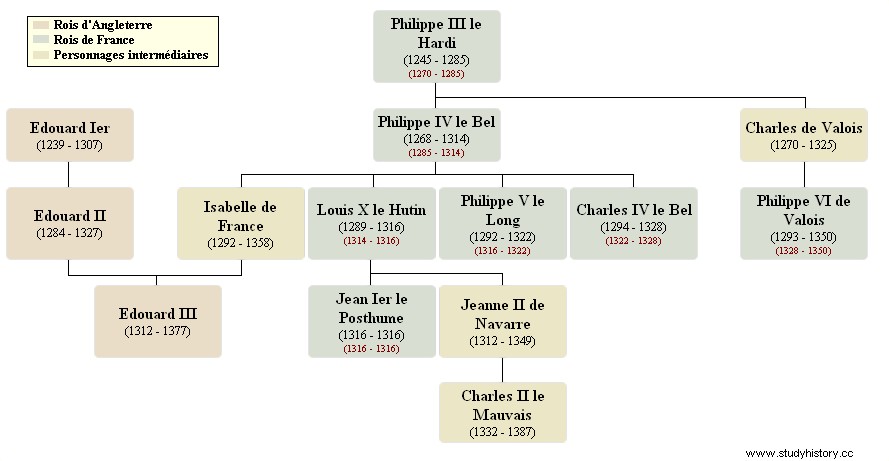
Philip VI:King of France
It is the peers of France who elect Philippe de Valois king of France. This one has the advantage of being neither English nor Navarrese. To rule out the two other suitors, the Salic law was invoked, that old Frankish law which forbids the transmission of the crown by women. We showed an old document to prove it, but the legitimacy of the new king is fragile. If Edward III accepts his eviction rather well, it is not the same for the King of Navarre. The son of Joan of Navarre, Charles the Bad will never accept his expulsion and will try by all means to harm the Valois. Upon his accession to the throne, Philippe therefore tried to assert his authority, he hastened to crush the Flemish army, insurgent against their count Louis de Nevers, on Mount Cassel in 1328. Philippe then reminded the king of England that he owed him homage for his possessions in Guyenne. Indeed, the King of England still owns part of Aquitaine, and he is therefore a direct vassal of the King of France. This is done at the cathedral of Amiens in 1329.
Edward III paying homage to Philip VI
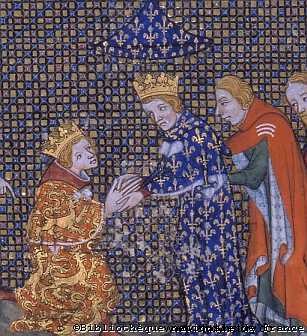
(National Library of France)
The real cause of the antagonism
The homage paid by the English sovereign to the King of France clearly shows that the succession dispute is only a pretext for war. Edward III just wanted to keep his possessions in Aquitaine. And when Philippe wanted to get his hands on the Duchy of Guyenne, the last stronghold of the King of England in France, Edward III started the war. At the origin of the conflict, it was above all a question of extending the royal domain, or, for Edouard, of maintaining his positions. Philippe took Bordeaux in 1337, he was soon supported by the Count of Flanders. Edward III reacted immediately by putting an embargo on the export of English wool which allowed the Flemings to derive their wealth (Flemish sheets were sold throughout Europe). Soon, it is a new revolt of Flanders, the insurgents of Ghent line up on the side of the English king. Then, from Westminster, Edouard publicly challenges Philippe. A few months later with his Flemish allies, Edward publicly takes the title of King of France. In 1339, the first battles, Edouard ravaged the countryside of Thiérache. The continuation of the English operations does not give anything on ground, but on sea, the French fleet of the Sluis is crushed. In 1340, the two sovereigns signed a truce, extended until 1345.
The War of the British Succession (1341 - 1364)
From 1341, another conflict will indirectly oppose French and English. A war rages for the succession to the Duchy of Brittany after the death of Duke John III. This war is also called "war of the Two-Jeanne" Two clans clash:
- That of the supporters of Charles de Blois and his wife Jeanne de Penthièvre (niece of Jean III), who have the support of the King of France Philippe VI.
- That of Jean de Montfort (brother of Jean III) and his wife Jeanne de Flandres, who, after having taken possession of almost all of the duchy, went to seek the alliance of Edward III.
Events, at first, seemed favorable to the "protege" of the King of France when Jean de Montfort was captured after the capture of Nantes. However ! His wife, Jeanne de Flandres will organize the resistance and manages to bring back reinforcements from England. The English are victorious at Morlaix. The conflict drags on, and the local population bears the brunt of the atrocities of both sides. In 1364, during the Battle of Auray, Charles de Blois was killed. The son of Jean de Montfort can now assert his rights to the crown.
Battle of Auray
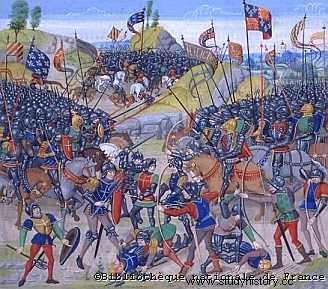
(National Library of France)
The French slump
The Battle of Crécy
In 1346, hostilities resumed between the French and the English. Edward III landed in the Cotentin, invaded Normandy and marched on Paris. Impressed by the army that Philip VI had just raised, he fell back to the Somme and camped at Crécy to rest his troops and stock up on food. But the King of France pursues him stubbornly. The latter stops at Abbeville where reinforcements reach him. On August 26, the English army, freshly rested, awaits the French on the heights. Edward III organized his troops skilfully in order to keep them ready to respond to the attack of the French cavalry:his archers were placed in such a way that each group was covered by another. Behind them, the carts containing the supply of arrows were arranged in an arc, thus protecting horses and riders. On the French side, it's anarchy! The army left Abbeville early in the morning; very sure of her strength, she thinks she can overcome the enemy very easily and the organization leaves something to be desired. Suddenly, the English are in sight! At this announcement, the King of France tries to gather his troops, in vain; It is already too late. The rearguard trying to join the vanguard, the disorder is such that we can not even distinguish the banners from each other. However, three groups were finally formed:the Genoese crossbowmen, the Count of Alençon's men and finally the king's men. A violent storm broke out, making the terrain muddy and impassable. In such a situation, how on earth do you reload the crossbows? The men are more tired of their march, remember that weapons and bolts weigh up to 40kg. Nevertheless, here they are advancing. They are received by dense volleys of arrows, so thick that "it seemed like snow", said Froissart. The men fled on all sides, hampering the soldiers. The king is furious. Order is given to the horsemen to kill this foot soldiers in flight and to attack! The knights fight bravely, of course, but to no avail. The king himself throws himself into the fray, and sees two horses die under him. At nightfall, everything is over, the English victory is as unexpected as it is brilliant.
Crécy in figures
- Strengths present:
- France:36,000 men including 15,000 Genoese mercenaries (crossbowmen)
- England:12,000 men including 7,000 archers
- French losses:
- 11 princes including Charles, count of Alençon, brother of the king and Jean de Luxembourg, king of Bohemia
- 1,250 knights
- 15,000 men-at-arms including 6,000 Genovese
- English arrows drawn:
- Over 500,000!
The defeat at Crécy
Crécy marks a turning point in war strategy:bombards appeared for the first time in a pitched battle. Not very effective due to their limited range, they nevertheless frightened the French troops and their horses, thus contributing to the distressing disorder of the French army. The chivalry goes into decline, the knights are beaten by the infantry.
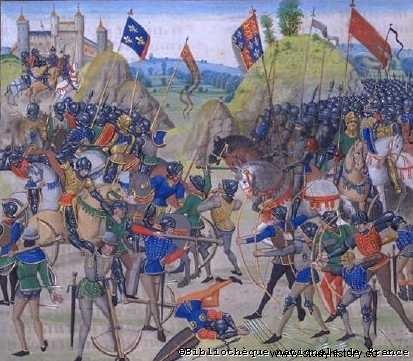
(National Library of France)
The Great Plague
In addition to the war, a terrible scourge, the plague, fell on France and all of Europe. Coming from the East, more precisely from the high plateaus of Iran, where it existed in an endemic state, it was propagated by a certain type of rat and spread like wildfire in 1347. The essential reason for this propagation was the overpopulation of the main countries of Europe, which, coming after great food shortages, increased the vulnerability of the population. City dwellers and religious communities, because of their concentration, were particularly affected. The plague reached Italy, southern France, Spain and in 1349 reached Germany, central Europe and England. The question was asked:who was responsible for this cataclysm? Some found scapegoats:the Jews. Accused of deliberately spreading the contagion, they were massacred or burned by the thousands; stakes were erected in Strasbourg, Mayence, Speyer, Worms. The pope came to threaten with excommunication those who persecuted the Jews. Others saw in the plague the punishment of God and incited to expiate the faults committed. When it disappeared around the middle of the century, it had carried off a third of the population.
The Black Death
The plague fell on France in 1348, it arrived there by merchant ships from the East. Since the causes of the disease were not known, the sick were not cared for and the dead were not buried, which favored contagion.
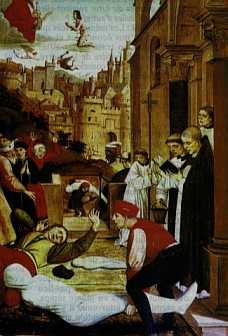
New defeats
After the capture of Crécy, Edouard comes to lay siege to Calais. After months of sieges, six citizens of the city, bareheaded and barefoot, in shirts and ropes around their necks, went before the King of England to place their lives and the key to the city in his hands. They thus managed to avoid the destruction of Calais and had their lives saved thanks to the intervention of Queen Philippa of Hainaut. It is a success for England, a permanent bridgehead is thus created, destined to remain English until 1558. In 1350, Philippe VI dies, his son Jean le Bon succeeds him. Very quickly, the new king must face the intrigues of Charles the Bad, the king of Navarre, this one does not hesitate to plot assassinations and alliances with England. Jean II le Bon ends up capturing it in Rouen, but the supporters of the King of Navarre still hold Normandy. Taking advantage of this conflict, the English launch two rides:
- One part of Brittany under Henry of Lancaster (future King of England).
- The other part of Guyenne under King Edward's son, the Prince of Wales. Nicknamed the Black Prince because of his armor, he leads bloody expeditions in the French countryside. The English pillage the villages and towns.
The Battle of Poitiers
Faced with the rides of the Black Prince, Jean le Bon cannot react because he lacks money. He united the States General in 1356 in order to raise an army. To pursue the English effectively, he keeps only the faster horsemen. The fight will take place south of Poitiers, on uneven ground cut by hedges, Jean II le Bon decided that the fight would be done on foot. Believing in an escape from the English, the French engage in a path lined with hedges, thus becoming easy prey for the English archers. Subsequently, the two main battlefields engage in disorder. The battle quickly turns in favor of the Black Prince. Sensing defeat approaching, Jean le Bon decides to send his three eldest sons to Chauvigny. Only the youngest Philippe le Hardi (future Duke of Burgundy), 14, remained at his father's side, recommending these famous words to him:"Father, keep to the right, father, keep to the left!" » But the king is quickly surrounded, and even captured by the enemy. The defeat is disastrous, ten years after Crécy, the kingdom is plunged into the most serious crisis of its history. In the absence of the king, the states general of langue d'oil (states of the north) meet without delay and decide to free Charles the Bad in the hope that he will protect the country in defeat. But the treacherous Navarrese comes into contact with the English to appropriate new fiefdoms.
Capture of John II the Good
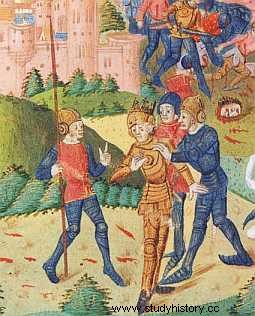
Urban riots and uprisings
- Urban riots :During this time in Paris, the bourgeoisie rose up against the nobility and the Dauphin, the future Charles V. the abolition of certain privileges and the control of taxes. In fact, Etienne Marcel dreams of making his city autonomous, like certain Flemish or Italian cities. One day in 1358, he burst into the Dauphin's chamber, having his marshals assassinated in front of him. The poor 18-year-old dolphin is crippled and unable to carry a sword. He is soon forced to wear a riding hood in the red and blue colors of the city. But the Dauphin manages to escape in an incredible way, and soon lays siege to Paris with his troops. As he was preparing to give the keys to the city to Charles the Bad, Etienne Marcel was assassinated. The heir to the throne can then make his triumphal entry into the capital. Later, he will erect the Bastille to keep the turbulent Parisians at bay.
- La Jacquerie :In the countryside, the exasperation due to the unpopularity of the nobility after the defeat of Poitiers and to the misery caused by the war and the plague caused an explosion. The Jacques (from the nickname of Jacques Bonhomme that the masters gave to their servants) set fire to the castles and threatened the lords. The repression, especially in the region of Beauvais and Meaux, was terrible, and thousands of peasants were massacred.
Assassination of Étienne Marcel
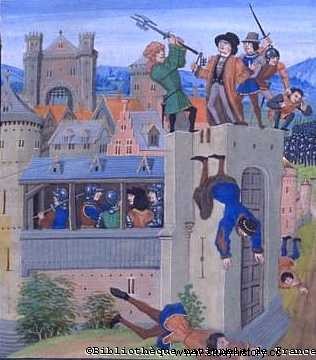
The French burst
The difficult recovery of France
Imprisoned in the Tower of London, John the Good promised his jailer, Edward III, a ransom of 4 million gold crowns in exchange for his release as well as all the possessions of the Plantagenets. But the Dauphin Charles, crowned with his victory against the Parisian bourgeois, does not hear it that way. Edward III then attempted a new landing aimed at having him crowned in Reims. Exhausted by long sieges, the English are forced to withdraw from the territory. The Treaty of Brétigny was signed in 1360, the English gained new possessions in France. King Jean le Bon is freed, but he makes himself a voluntary prisoner a few months later:his son Louis of Anjou who was used as a hostage had fled to join his wife. Finally John II died in captivity in 1364. Charles V, known as the Wise, ascended the throne, was the architect of the recovery of France. Cultured, collector of rare manuscripts and works of art, loving to surround himself with writers, painters, musicians, he had the Louvre rebuilt and founded the royal library there. A hard worker, he knew how to surround himself with good ministers. Thanks to a new tax on salt, the gabelle, he restored the finances of the crown. Intelligently drawing lessons from the failure of Poitiers, he reorganized the army:no more epic cavalcades of feudal barons! Henceforth, a permanent militia proceeding by guerrilla operations rather than deadly frontal engagements would form the basic element.
The birth of the franc
After paying part of his ransom, Jean le Bon is released from captivity. In 1360, he created the franc, to commemorate his liberation (franc =freedman). This currency supplements the Saint Louis gold shield and the silver tournament pound. The 1360 coin represents the king on horseback, a second edition in 1365 will represent the king on foot (the "franc à pied").
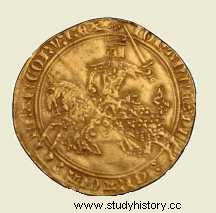
Bertrand du Guesclin, Constable of France
Bertrand du Guesclin was born near Rennes in 1320. Dull skin, almost black, the baby was apparently so ugly that his father did not want to recognize him. Jostled, beaten because of his ugliness, Bertrand returned as soon as he could blow after blow. One day, the child rebelled against his brothers and knocked over a long table, an oriental nun calmed him down and predicted that he would one day be Chief of Chiefs and the Lilies will bow down to him . Later, during a tournament where he is forbidden to participate, he defeats all his opponents, before refusing to fight his father. He thus forged a strength of character and an athletic body that would bring him to the highest dignity of the kingdom after the king. Indeed, in 1370, Charles V gave Bertrand du Guesclin the sword of Constable of France (chief of the armies). Until that date, the proud Breton was at the head of a band of peasants whom he had trained himself to fight according to the principles of "guerrilla warfare":the ax hanging from their necks, it was a question of to harass the English, vile occupiers of his Breton land. While Henri de Lancastre leads a ride in Brittany, Bertrand shines during the defense of Rennes. Charles de Blois dubbed him a knight in 1357. From then on, during the conflict of Succession of Brittany, Du Guesclin sided with him against Jean de Montfort.
Legend or fact
A legend ran about the origin of the Guesclin family. It would go back to Charlemagne, a fleet of Saracen ships, led by a king named Acquin, approached the coasts of Brittany and devastated the surroundings. Charlemagne rushed up in person, and threw the invaders back into the sea. The panic was such that the Saracens abandoned tents and equipment on the beach; among all this was a child, Acquin's own son. Charlemagne made him his godson and baptized him. He gave him tutors and made him a knight to whom he granted the castle of Glay which became the fief of Sire Glay-Acquin. We are not far from Du Guesclin.
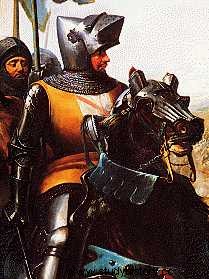
Bertrand du Guesclin at the Battle of Cocherel (1364)
The constable in the service of his king
In 1357, Du Guesclin was in the service of King Charles V. He took part in all the battles between the royal troops and the English and Navarrese. He obtained his first victory at Cocherel (near Evreux) in 1364, defeating the army of Charles the Bad. Then, it is the same year, the defeat of Auray for the succession of Brittany. He will be taken prisoner, the king then hastens to pay his ransom. Bertrand du Guesclin then engages in a fight against the scourge of the time:“the Great Companies”:unemployed mercenaries who had gathered in the Côte d'Or. These notorious companies engaged in abuses of all kinds. A solution had to be found to get rid of these looters. Du Guesclin, who was the only man with sufficient authority to muster them, took them with him to fight in Spain. The future constable had in mind to lead the fight against Peter the Cruel, an ally of the English, who disputed the kingdom of Castile with his brother Henry of Trastamare. Du Guesclin succeeds in conquering Castile but he is captured by the Black Prince. The king again paid the ransom. Freed, Du Guesclin managed to defeat his enemy at the battle of Montiel in 1369. As for the Great Companies, they gradually fell into decline. From 1370 to 1380, always using a very personal tactic of harassing the adversary starting from captured and well-defended strongholds, Du Guesclin succeeded in driving the English out of almost all of the occupied French territory (Aquitaine, Poitou , Normandy, etc.). In 1380, he died at the siege of Chateauneuf-de-Randon in Auvergne. Charles V had him buried, a unique event for a man who was not a king, in the royal basilica of Saint-Denis, alongside the kings of France. The king, victim of illness, soon joined him.
The title of Dolphin
During the reign of Jean le Bon, Dauphiné was attached by donation to the crown. From now on the heir apparent to the crown will receive this territory and will therefore bear the title of Dauphin. The first dolphin will therefore be Charles V, thereafter this title will be used to designate the heir to the throne of France (generally the eldest son of the king).
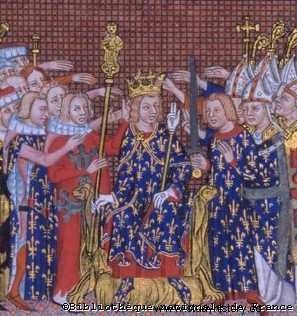
(National Library of France)
New troubles
Charles VI “the Beloved” or “the Fool”
Before his death, Charles V had abolished the fouages (tax levied on each household), thus depriving the monarchy of resources. When he died, his son Charles VI was only twelve years old. It was his uncles, the Dukes of Anjou, Berry, Burgundy and Bourbon who governed the kingdom. Taking advantage of their situation, they squander the resources of the kingdom and decide to introduce new taxes for their personal profit. In 1383, it was the revolt of the “Maillotins”:Parisians armed with mallets took to the streets to show their discontent. In 1388, Charles VI took over the affairs of the kingdom, he expelled his uncles and recalled his father's former advisers, whom the princes called the "Marmousets" (among them the Constable Olivier de Clisson). For his subjects, Charles VI becomes "the Beloved". In 1392, the fate of this king will literally change. While crossing the forest of Le Mans, during an expedition against the Duke of Brittany, the king takes the members of his suite for his enemies and attacks them brandishing the sword. Six knights are killed before we can subdue him. The brutal madness of the king worsens the following year. The subjects of the kingdom fear a return of the uncles of Charles VI to power. But through his crises of madness, the king regains access to lucidity and governs with wisdom. No one then dares to place the king under guardianship.
Madness of Charles VI
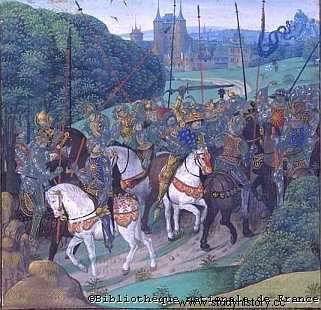
Armagnacs versus Burgundians
From 1392, Queen Isabeau of Bavaria presided over an eventful Regency Council. Two factions then clash, culminating in a serious civil war:
- The Orleans Party (later called Armagnacs) from the brother of Charles VI:Louis d'Orléans (grandfather of the future Louis XII).
- The Burgundian Party of the powerful uncle of Charles VI:Philippe le Hardi. Duke of Burgundy, Philippe inherited the prerogative entrusted by his father Jean le Bon, he obtained Flanders thanks to his marriage. At the head of an immense kingdom, his descendants will gradually break away from the kingdom of France.
During this time, France outlines a rapprochement with England. The King of England, Richard II marries the daughter of Charles VI. The two sovereigns meet without reaching terms of peace. In 1399, Richard II was overthrown by Henry of Lancaster, it was the end of attempts at pacification between the two kingdoms. The rivalry continues to grow between Louis d'Orléans, who is at the head of the French army, and the new Duke of Burgundy, Jean Sans Peur. The latter had Louis d'Orléans assassinated in 1407, in the Marais district of Paris. This assassination marks the beginning of the civil war. The victim's son, Charles d'Orléans, asked his father-in-law Bernard VII, Count of Armagnac (hence the name of the faction) for support. Armagnacs and Burgundians dispute the places and resources of the kingdom, not hesitating to appeal to England. Jean Sans Peur soon manages to dominate Paris. Very popular, the Duke enjoys the support of the University and a restless corporation of butchers, led by Simon Caboche. In 1413, the latter obtained a major administrative reform:the Cabochian ordinance. But the persistent troubles worry the Parisian bourgeoisie, which is getting closer to the Armagnacs. Count Bernard VII becomes master of Paris and is made constable by Queen Isabeau of Bavaria.
The Dukes of Burgundy
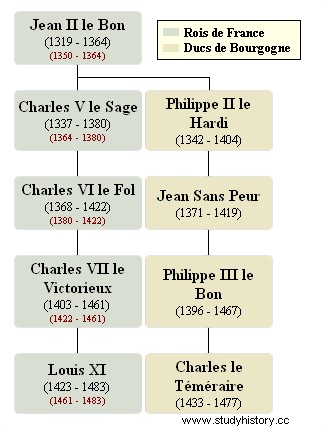
The Battle of Agincourt
The fratricidal quarrels sweeping France have not escaped the notice of the new King of England, Henry V of Lancaster. The latter took the opportunity to relaunch the war, he landed with his troops in Normandy. Henry V is the son of Henry IV, the usurper who had Richard II, the heir to the Plantagenets, assassinated. He wishes to review the English ambitions on the French crown, and failing that, to regain a part of the continent lost thanks to the campaigns of Bertrand du Guesclin. As soon as he landed in France, the English sovereign took refuge in Calais. The French army is organized around Armagnacs. Once again, they have the numerical advantage, but despite the defeats of Crécy and Poitiers, the French chivalry has lost none of its arrogance. Despite the advice of the Duke of Berry, the French decide to attack the English in a narrow passage, where it is impossible to deploy. Already tired from the long night of waiting in the rain, the knights charge with the sun in their eyes. With their heavy breastplates, they struggle to move and are greeted by a volley of English arrows. English pedestrians soon come at the feet of the knights, beating them with maces and swords. The prisoners are slaughtered. Agincourt is one of the deadliest battles of the Middle Ages with 10,000 losses on the French side. Once again, many French barons are killed, Charles d'Orléans, nephew of the king and father of the future Louis XII is captured and will remain 25 years in England. The French chivalry which remained the elite of the kingdom for two centuries is in decline. Its ancestral virtues like courage, faith and sacrifice are swept away by military strategy. Once again a handful of infantry defeated a horde of knights.
Battle of Agincourt
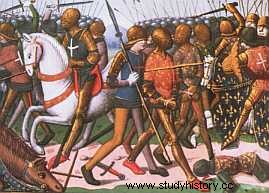
(manuscript by Martial d'Auvergne, 15th century, BNF)
Civil War
The inaction of the Armagnac clan, still in power, encouraged Henry V to broaden his plans. He lands in Normandy and organizes a methodical conquest. En 1417, Jean Sans Peur et Isabeau de Bavière installent à Troyes, un gouvernement rival de celui du dauphin. A Paris, les Armagnacs ne s'imposent que par la terreur. En 1418, une violente émeute les chasse de la ville. Le comte Bernard VII et les siens sont froidement massacrés. La nuit du 20 août, les pillages et les massacres se poursuivent. On compte plus de dix mille morts. Le prévôt de Paris rentre dans la chambre du dauphin (le futur Charles VII), organisant sa fuite à cheval. Âgé de 15 ans, le dauphin part se réfugier à Bourges dans le duché de Berry qu'il a hérité de son grand-oncle. C'est un triomphe pour Jean Sans Peur et ses alliés anglais. Le duc de Bourgogne manœuvre à sa guise le roi Charles VI et sa reine Isabeau de Bavière. Ayant fait alliance avec les Anglais pour son intérêt personnel, Jean Sans Peur en vient cependant à s'interroger au vu de l'invasion anglaise sur le territoire national. Il souhaite faire une ultime tentative de réconciliation avec le dauphin. Les deux partis semblent disposés à mettre fin à leur rivalité qui ne sert que les intérêts anglais. Une entrevue a lieu sur le pont de Montereau en 1419, Jean Sans Peur s'y rend sans protection. C'est alors qu'un conseiller du dauphin, Tanguy du Châtel lui porte un coup de hache au visage, Jean Sans Peur est roué de coups puis assassiné. Naturellement, le meurtre horrifie le pays et ranime la querelle entre Armagnacs et Bourguignons. Charles VI se laisse convaincre par les Anglais de déshériter son fils et signe l'ignominieux traité de Troyes (1420). La fille de Charles VI est promise au roi d'Angleterre qui devient le successeur au trône de France. Il fait une entrée triomphale à Paris aux cotés de Charles VI. Il semble bientôt qu'un roi anglais régnera sur le royaume de France !
L'assassinat de Jean Sans Peur
La réconciliation entre Armagnacs et Bourguignons aurait dû constituer le relèvement français. Mais il n'en est rien, l'assassinat de Jean Sans Peur plonge le pays dans ses heures les plus noires.
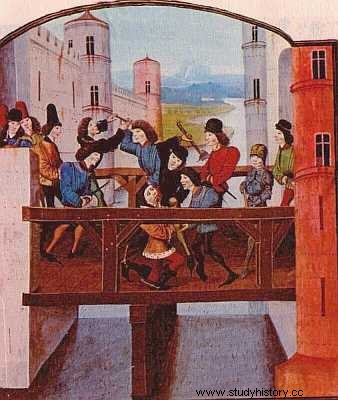
Accèder à l'article suivant :Jeanne d'Arc
